 TRIZ/CrePS paper: Toru Nakagawa TRIZ/CrePS paper: Toru Nakagawa |

  |
From the "Four-Box Scheme of Abstraction" in Science and Technology to the "Six-Box Scheme" for Creative Problem Solving |
Toru Nakagawa (Osaka Gakuin University),
Conference of Japan Creativity Society, (Online) Oct. 3, 2021.
|
Posted in the Japanese page  (Dec. 10,2021) (Dec. 10,2021)
and briefly
introduced here in English (Jan. 14, 2022, Toru Nakagawa)
Paper  and slides and slides  in English are posted in this page (Feb. 19, 2022, Toru Nakagawa) in English are posted in this page (Feb. 19, 2022, Toru Nakagawa)
|
Extended full paper (in Japanese) has been publicized in "TRIZ Home Page in Japan"  (Jul. 22, 2022). (Jul. 22, 2022). |
| Posted: Jan. 14, 2022; Updated: Feb. 19, 2022, Jul. 22, 2022 |
For going to Japanese pages, press  buttons.
buttons.
 Editor's Note (Toru Nakagawa, Jul. 30, 2022)
Editor's Note (Toru Nakagawa, Jul. 30, 2022) 
Extending this Proceeidngs paper (8 pages), a full paper (of the same title, 20 pages)  has been written in Japanese and publicized in this "TRIZ Home Page in Japan" on Jul. 22, 2022. The paper was written and submitted to the Journal of Japan Creativity Society on Dec. 18, 2022. However, JJCS rejected my paper saying NOT "a new, unpublished, original work", and on my claim of this paper being "a full, new, overview paper of my original work for over 20 years", they decided not acceptng an overview paper (in Feb. 2022). Thus I posted my paper in this website, together with my review request to the JJCS Editors in Japanese. Translation into English may be delayed much.
has been written in Japanese and publicized in this "TRIZ Home Page in Japan" on Jul. 22, 2022. The paper was written and submitted to the Journal of Japan Creativity Society on Dec. 18, 2022. However, JJCS rejected my paper saying NOT "a new, unpublished, original work", and on my claim of this paper being "a full, new, overview paper of my original work for over 20 years", they decided not acceptng an overview paper (in Feb. 2022). Thus I posted my paper in this website, together with my review request to the JJCS Editors in Japanese. Translation into English may be delayed much.
 Editor's Note (Toru Nakagawa, Jan. 14, 2022)
Editor's Note (Toru Nakagawa, Jan. 14, 2022)
Paper: From the "Four-Box Scheme of Abstraction" in Science and Technology to the "Six-Box Scheme" for Creative Problem Solving (Toru Nakagawa)
This paper has been presented in Japanese at the Conference of Japan Creativity Society on Oct. 3, 2021. A full set of records, i.e., paper (8 pages) in the Proceedings (in HTML  and in PDF
and in PDF  ), presentation slides (21 slides in PDF
), presentation slides (21 slides in PDF  ), and (rehearsal) video (25 min. in MP4
), and (rehearsal) video (25 min. in MP4  ), have been posted in Japanese on Dec. 10, 2021.
), have been posted in Japanese on Dec. 10, 2021.
I have simplified my preceding 90 minutes lecture at the Art Thinking Workshop of Meiji University (Jun. 27, 2021) by shortening the middle transient TRIZ/USIT part for focusing on the Six-Box Scheme in contrast to the conventional Four-Box Scheme.
Note: "Methodology for Creative Problem Solving: TRIZ and its Extension -- Scientific methodology for Innovation", Toru Nakagawa, Presented at Art Thinking Workshop of Meiji University (Online), Jun. 27, 2021.
Posted in "TRIZ Home Page in Japan" on Jun. 23 and Jul. 7, 2021, in the forms of presentation slides (in HTML 
 and PDF
and PDF  ) and also publicized in YouTube in six parts of videos in MP4
) and also publicized in YouTube in six parts of videos in MP4  .
.
("TRIZ Home Page in Japan" (Toru Nakagawa) Channel in YouTube:
https://www.youtube.com/channel/UCx_pLqJqSvZN3zv48bDhTYQ  )
)
This lecture has not been shown in English in my Website yet, to my regret.
[Editor's Note (TN, Feb. 19, 2022): The paper and the Slides have been posted here in English translation. See Paper in HTML  and in PDF
and in PDF  , and Slides in HTML
, and Slides in HTML  and in PDF
and in PDF  . ]
. ]
I have shown:
(a) "Four-Box Scheme of Abstraction" is the basic paradigm in science and technology in general, but it is not applicable to creative problem solving.
(b) Conventional researches and applications of Creativity Methods have been working in various approaches being confused without finding a suitable paradigm.
(c) TRIZ and USIT have prepared for the transition to the new paradigm for Creative Problem Solving.
(d) The "Six-Box Scheme" obtained through TRIZ/USIT is found to be the new basic paradigm for Creative Problem Solving.
The figure illustrated "Four-Box Scheme" and "Six-Box Scheme" side by side.

"Four-Box Scheme" expresses "common terms" of various established theories in wide ranges of science and technology. It has been used in every area of science and technology and has been taught in education from junior high school level. However, its processes, i.e., abstraction, reasoning, and concretization, cannot be explained in general without using examples.
On the other hand, "Six-Box Scheme" illustrates the skeletal process to be followed when trying to solve a new problem/issue ("creative problem solving"). For each step of the process, many general theories and methods are already known for guiding users closely. It is this "framework", or basic paradigm or guiding principle, that has to be revealed so far.
You may feel this diagram simple and apparently "obvious" or "nothing new". (Then please recall the anecdote of Columbus' Egg.) However, this is the new basic Paradigm for "Creative Problem Solving", namely all the important work in Research and Development and in various Innovations. I realized and proposed this "Six-Box Scheme" 16 years ago in 2005 

 . We hope the new paradigm become widely known and effectively applied in Japan and all over the world.
. We hope the new paradigm become widely known and effectively applied in Japan and all over the world.
 Paper in English translation (Toru Nakagawa, Feb. 18, 2022) ==> in PDF
Paper in English translation (Toru Nakagawa, Feb. 18, 2022) ==> in PDF 
Table of Contents
Abstract: 
1. Current Situations of the Basic Paradigm of Science and Technology 
1.1 The Basic Paradigm of Science and Technology Is the "Four-Box Scheme of Abstraction".
1.2. Diversity of "Creativity Methods": Different Approaches Exploring [without a Paradigm]
2. Recent Development in Search of Creative Problem Solving Methodologies 
2.1 TRIZ (Theory of Inventive Problem Solving)
2.2 USIT (Unified Structured Inventive Thinking)
3. The "Six-Box Scheme": A New Paradigm of Creative Problem Solving. 
3.1 The concept and usage of the "Six-Box Scheme"
3.2 Examples of description and usage of the "Six-Box Scheme"
3.3 Significance and Positioning of the "Six-Box Scheme"
3.4 Understanding Various "Creativity Methods" Using the "Six-Box Scheme"
4. Concluding Remarks 
References 
[Note (TN, Feb. 17, 2022): Several sentences in [ ] in blue fonts are inserted in this English translation for clarifying the intention of the paper.]
From "Four-Box Scheme of Abstraction" in Science and Technology
to "Six-Box Scheme" of Creative Problem Solving.
Toru Nakagawa (Osaka Gakuin University; CrePS Institute)
Proceedings of Japan Creativity Society Conference 2021,
held at Kurume University (Online), on Oct. 2 - 3, 2021
Abstract: Science and technology have the "Four-Box Scheme of Abstraction" as the basic paradigm, and solve problems by applying them to models (theories) established in every field. This is not effective for "Creative Problem Solving", where a new way of thinking (theory) itself is to be found. Thus, various researches on "Creativity Methods" for Creative Problem Solving have made different approaches without a basic paradigm. Among them, TRIZ and USIT have prepared for a new development. The author introduced both of them, integrated the huge TRIZ into the concise USIT, and from the data-flow representation of the USIT process obtained the "Six-Box Scheme". Having shown many TRIZ/USIT problem solving cases in the "Six-Box Scheme", he is advocating the Scheme as a new "Basic Paradigm of Creative Problem Solving". Now that the Scheme has established the problem-solving process in the "Thinking World", the diversity of problem situations in the "Real World" is the focus of research in future. It would be meaningful to examine various Creativity Methods and reposition and integrate them in the "Six-Box Scheme". [Note 1]
Keywords: Four-Box Scheme of Abstraction, Six-Box Scheme of Creative Problem Solving, Basic Paradigm, Creativity Methods, TRIZ/USIT
[Note 1] This paper is written down as a revised version of a lecture (90 minutes) [1] in which the author reviewed his research, while compressing the middle parts.
1. Current Situations of the Basic Paradigm of Science and Technology
1.1 The Basic Paradigm of Science and Technology Is the "Four-Box Scheme of Abstraction".
Science and technology support almost all of human culture, and enormous and extensive researches, developments, applications, and educations are conducted day and night over the world. As the most basic thinking methods and guiding principles (i.e., "Paradigm") in every field, of science and technology, we may regard the "Four-Box Scheme of Abstraction". (Figure 1)

Figure 1: Four-Box Scheme of Abstraction [8].
The Paradigm advises: For solving a specific problem, we should better abstract the problem and use some known generalized model (or theory), instead of trying to solve it specifically/individually. Since the solution methods (or solutions) for the generalized problem is already known, we may use them as references (or hints) and go back to our own specific problem for coming up with some concrete solutions. A simple example following this paradigm is the usage of the quadratic equations and the root formula in mathematics. This way of thinking is taught and used everywhere from school education to professional activities.
In accordance with this Paradigm, abstract models (or theories) have been developed in every field and for various problems individually, and accumulated and used as vast knowledge systems in science and technology. However, since the actual method of abstraction depends on the (individual) model, we need to select a model first and then to fit our specific problem to the model.
In the cases of solving problems which require inventions or innovations (i.e., "Creative Problem Solving"), models we can use are often not clear or do not exist yet, and hence the "Four-Box Scheme of Abstraction" is not effective. [Saying more clearly, "Four-Box Scheme of Abstraction" is a paradigm for applying some established models, and is not a paradigm for finding/developing a new model (or theory/product, etc.) (i.e., for "Creative Problem Solving"), in science and technology in general.]
1.2. Diversity of "Creativity Methods": Different Approaches Exploring [without a Paradigm]
Therefore, various methods for "Creative Problem Solving" have been explored [2]. The foundation of these approaches is learning successful experiences of many scientists and engineers from ancient times till the present. Many of the success stories are described as having been "inspired/enlightened", and the process getting the inspirations has been found almost commonly as follows. [Based on G. Wallas [1A], with slight modification in (b).]
(a) Have basic knowledge, and carrying out studies and researches,
(b) Being aware of an issue, having been thinking about it for a long time, thinking and trying various different ways. (During this time, our brain is supposed to be working subliminally for generating various ideas by combining a huge number of memories stored in our brain.)
(c) At a relaxed state of mind, with some small event, dream, etc., an "Inspiration" has come out.
(d) Applying it to the problem, have succeeded to make a clear solution.
According to this finding, we understand that we have to work hard for a long time, but we can't know when and whether we will get the "inspiration". Anyway, using this knowledge as a hint, various ways of researches and practices have been explored in the world. For example:
1. Anyway, let's take time to study, research, do experiments, and make various trials.
2. Try to generate ideas freely and abundantly and make trials of them.
3. Encourage imagination and fantasy. Think in animation.
4. Train ourselves to think flexibly from different perspectives.
5. Think with hints of various examples; Look for and collect hints.
6. Survey and study literatures and patents, and use them as references.
7. Describe and analyze the problems and tasks.
8. Prepare time/occasions, places, and environments for getting relaxed.
9. Meet and discuss with people having different backgrounds, ideas, experiences, specialties, etc.
・・・・・・
Examples of methods created with these various approaches (i.e., so-called "Creativity Methods" [2, 3]) are shown in Table 1.
Table1: Examples of "Creativity Methods" for Creative Problem Solving [9].

For these many decades, these numerous and diverse "Creativity Methods" have been advocated and practiced in uncoordinated/confusing ways. Each of them aims at a "shortcut" and is effective individually but partially; resulting the whole system is not clear. [This means that "Creativity Methods" do not have its skeletal framework (or a basic paradigm). This statement is also the same as that the "Four-Box Scheme of Abstraction" in science and technology is not effective for "Creative Problem Solving" and that "Creative Problem Solving" has not found its basic paradigm yet.]
2. Recent Development in Search of Creative Problem Solving Methodologies
2.1 TRIZ (Theory of Inventive Problem Solving)
TRIZ was developed since 1946 and established by Genrich Altshuller in the private sector of the former Soviet Union, and has been spread to the western world since 1990s and are now used in many countries worldwide. Starting with patent analyses, he created a system of knowledge bases that hierarchically organized scientific and technological information into various principles and their applications in a user-friendly way from several perspectives. TRIZ is also remarkable for having created systemic thinking and effective thinking methods to formulate and solve contradictions. [5]
Figure 2 shows the four main methods developed by TRIZ. Each method is based on the "Four-Box Scheme" and accompanies a large-scale knowledge base of scientific and technical information organized in its own way.
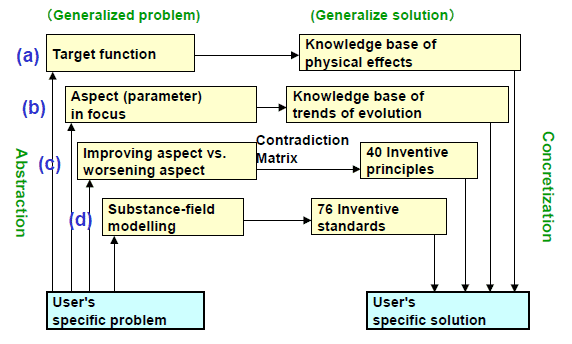
Figure 2: The four main problem solving methods of TRIZ [5].
(a) In order to find some means to achieve a target function, the method explores various scientific & technological principles and their technical application examples.
(b) Putting the focus on some aspect of the system's main part, the method finds the evolution direction (or trends) of that aspect in various other systems and suggests some improvement of the system.
(c) The method formulates the problem as a contradiction in the form "when we try to improve one aspect of our problem system, some other aspect gets worse." Then the knowledge base of the method suggests, as hints, several solution ideas (in the form of "40 Inventive Principles") that were often used in precedent cases (of patents) successfully for solving such patterns of contradictions. The knowledge base (called the "Contradiction Matrix") was developed by the huge analyses of patents all over the world.
(d) The methods represents the core part of the problem system in the form of a (kind of) functional analysis, and, depending on the type of problem, suggests its (standard) solutions in the words of a functional analysis.
All these four methods have the great advantage that they are applicable across all fields of science & technology (and even wider in non-technological fields) and across all development stages of technology. [This is remarkable that TRIZ methods have the form of "Four-Box Scheme" but greatly overcome the limitation in the specific application fields in the "Four-Box Scheme" in Fig. 1.] However, TRIZ has four big methods in parallel, with focusing on different aspects of the problem system, and hence has the disadvantage that the whole process of TRIZ (such as in ARIZ) is complex and unclear.
2.2 USIT (Unified Structured Inventive Thinking)
USIT was developed in 1995 by Ed Sickafus (Ford Motor Company) by revising the Israeli SIT (Systematic Inventive Thinking) method, which greatly simplified the TRIZ solution generation methods into simple 5 methods. Sickafus created a concise and consistent process for Creative Problem Solving (See Fig. 3). In contrast to TRIZ, the USIT method does not rely on handbooks or software tools, but guides the users (mostly engineers) in their thinking process. [6]
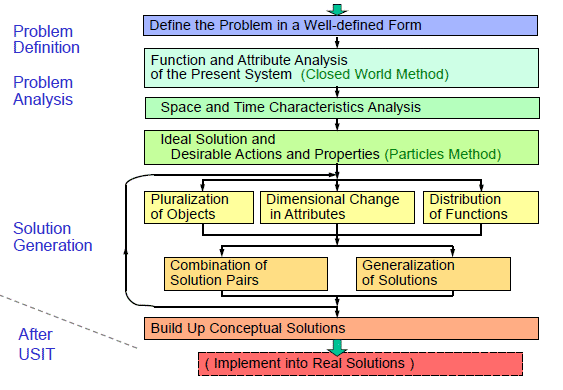
Figure 3: USIT process for Creative Problem Solving [4]
The present author introduced TRIZ in 1997 and USIT in 1999, and has been working to find a way to integrate the ideas and advantages of the two methods. In particular, all the solution generation methods of TRIZ (Fig. 2 and others) were disassembled into their sub-methods and reintegrated them into the five USIT solution methods, resulting the USIT operator system (having 5 solution methods containing 32 sub-methods) [7]. As a result, we have a general-purpose Creative Problem Solving Method that is easy to learn, easy to apply, and effective.
A jump occurred when I expressed the improved USIT process in a data-flow diagram in place of a flowchart (Fig. 3). The data-flow representation was refined into the "Six-Box Scheme" and realized to be the "Basic Paradigm of Creative Problem Solving", as explained in the next section [4, 8]
3. The "Six-Box Scheme": A New Paradigm of Creative Problem Solving.
3.1 The concept and usage of the "Six-Box Scheme"
The "Six-Box Scheme" is represented and defined by the "data-flow representation" as shown in Figure 4 [4, 8].

Figure 4: The "Six-Box Scheme": a new Basic Paradigm of Creative Problem Solving [4].
The data-flow representation, in general, specifies and describes (in the boxes) the information (or data) to be obtained at each stage, and shows (with arrows and ovals) the process of thinking/handling for obtaining the information at each stage. It should be noted that the data-flow representation does not specify any further detail of processing, and allows for the variety and arbitrary choices of processing methods (and even returns and repetitions among the boxes).
In the "Six-Box Scheme", the upper and lower halves of the figure (as indicated by the rounded rectangles) are considered to belong to different worlds. The lower half is the "Real World," where the problems (or the tasks to be accomplished) exist and the solutions are to be implemented. There, we evaluate and choose the problems to deal with and the solutions to implement in terms of technology, business, society, etc., depending on our own situations. On the other hand, the upper half is the "Thinking World," where we use problem-solving methods as the guides for considering problems as broadly, freely, and deeply as possible (without being bound by reality), creating solution ideas, and presenting candidate solutions to the Real World.
Problem recognition (bottom left, Box 1) is carried out in the "Real World", where the person(s) in charge (e.g., managers of the company or the field) define the problem to address (Box 2) after considering the specific situations of technical, business, and social environments and selecting the problem with their value judgment. Then, the person(s) organize an appropriate Team and request them for solving the problem in the "Thinking World".
In the "Thinking World", we, the Team, start with reviewing the problem (Box 2) from our own standpoint. Then, we proceed to analyze and examine the problem. First task is to understand the present system having the problem (lower part of Box 3). We should understand the mechanism of the present system and examine the (root) causes of the problem from the perspective of space and time, system's components, their attributes (or properties), and functions. We should also think of an image of an ideal system that solves (or does not have) the problem (upper part of Box 3).
Next, we need to get (basic) ideas for a new system (Box 4). By virtue of the information we have obtained by the analyses up to Box 3, we are often activated to fully use our background knowledge to the stage that various ideas come out smoothly. In addition, we can enhance our idea generation by using various solution generation techniques (including TRIZ methods and USIT operator system, among others).
Then, starting with the basic ideas (Box 4) we go ahead to build conceptual solutions (Box 5) that would (should) certainly work effectively solving (or reducing) the problem. These are solution proposals at the conceptual level (or in the "Thinking World") desirably in multiple aspects, e.g., short-term/long-term, realistic/challenging, incremental/radical, etc. In any case, it is desirable that some of us, the team members, have specialty or at least sound background knowledge in this specific area (or else we need to get such knowledge/persons from outside).
We return the conceptual solutions (Box 5) to the "Real World" and report our reasonings and proposals. Managers and staff in the "Real World" examine the proposed solutions in their feasibility, effectiveness, economic factors, future potential, etc. on the basis of their actual situations of technology, business, and society, and adopt some proposals. The adopted solution proposals need to be processed further, such as designing, prototyping, improving, market investigation, mass production, etc. before being implemented as a new or improved product/service (Box 6). After appearing as a product in the market, sales promotion, maintenance/services, further improvements, etc. are necessary. [All these activities of implementation (from Box 5 to Box6) need to be carried out with full power of the organization for achieving success (i.e., Innovation) in the severe competition in the Real World.]
3.2 Examples of description and usage of the "Six-Box Scheme"
The "Six-Box Scheme" is the Basic Paradigm of Creative Problem Solving. This statement means that it is the outline of recommended process of Creative Problem Solving (where USIT is an example of a concise process) and that examples of good case studies carried out with various methods can be understood and described within this framework.
A number of case studies that the present author carried out with the USIT method are described in the "Six-Box Scheme", and publicized in [9, 10].
Here I introduce the case study of "Saving Water for a Toilet System" by K.W. Lee et al. [11], where they solved a contradiction problem elegantly with TRIZ, in a series of three slides (Fig. 5 - Fig. 7).



Figures 5, 6, 7: Case study of "Saving Water for a Toilet System" [4]
The whole process of the case study is represented in the "Six-Box Scheme" in Figure 8. The essence of this case study is that a "physical contradiction" (in the TRIZ terms) has been solved smoothly by following the stages in the "Six-Box Scheme": namely, recognition of the problem (Box 2), formulation of the contradiction (understanding the present system, lower part of Box 3), requirement based on the TRIZ separation principle (understanding the ideal system, upper part of Box 3), basic ideas stimulated with the understanding of the present and ideal systems (Box 4), and conceptual solutions build up from the ideas (Box 5). The "Six-Box Scheme" describes the whole process appropriately.
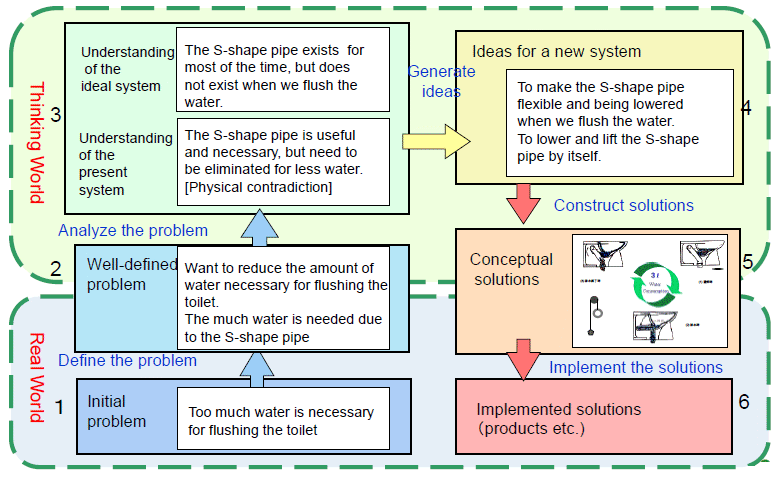
Figure8: "Six-Box Scheme" representation of "Saving Water for a Toilet System" [9].
3.3 Significance and Positioning of the "Six-Box Scheme"
The upper half of the "Six-Box Scheme" (Box 2 to Box 5) is the process in the "Thinking World", and corresponds to the "Four-Box Scheme of Abstraction" in science and technology (Fig. 1). However, we see fundamental differences between the two, as follows:
Firstly, the process of "abstraction" in the "Four-Box Scheme" is fitting to a selected existing model (or theory), while the process from Box 2 to Box 3 in the "Six-Box Scheme" is guided to understand the present system by the analysis in several perspectives and also to make an image of the ideal system.
Secondly, the "generalized solution" in the "Four-Box Scheme" is some preset answers in the model receiving as the suggestions of hints, whereas the ideas (Box 4) in the "Six-Box Scheme" we generate for ourselves as simple and basic ideas (instead of hints) for a new system. We can generate such ideas mostly by virtue of being stimulated with the information we obtained in Box 3 and also by the help of various idea generation methods (i.e., various "Creativity Methods", TRIZ/USIT, etc.).
Thirdly, the concretization process in the "Four-Box Scheme" is sometimes difficult because the suggested hints often seem not so relevant to our specific problem, whereas the corresponding process in the "Six-Box Scheme" can proceed smoothly (without such a difficulty) to think of and design new conceptual solutions (Box 5) out of basic ideas.
In this sense, the "Six-Box Scheme" is widely valid and effective in the "Thinking World" as the "Basic Paradigm for Creative Problem Solving".
On the other hand, the "Six-Box Scheme" in the "Real World" (i.e., the lower half of Fig. 4), however, faces with a major challenge. This is because the "Real World" is extremely diverse, as illustrated in Figure 9.

Figure 9: Position of the "Six-Box Scheme" of Creative Problem Solving
in the "Real World" [12].
The Real World that requires Creative Problem Solving (and hence the application of "Six-Box Scheme") is very diverse, including various industries and businesses, social and public organizations, educational and medical fields, etc.
As an example, the case of a manufacturing company is illustrated in Figure 9. A typical business process in the manufacturing industry is described in the lower part of the figure. In every process, different types of problems may arise in relation to all products and equipment. Whenever a problem (or business anticipation in the next few years, etc.) arises, the problem is taken up (Box 1) and after observing and evaluating problem situations some important problem (Box 2) is handed to the procedure in the "Thinking World". Varieties of problems encountered in this process are shown in the lower left corner of Fig. 9.
These variations affect not only on the problem definition (Box 1 to Box 2) but also on the activities in the "Thinking World" (Box 2 to Box 5) and on the realization of solutions in the "Real World" (Box 5 to Box 6). Methodologies of "Creative Problem Solving" in such diverse situations need to be developed further in future (even though some of them are under the way).
3.4 Understanding Various "Creativity Methods" Using the "Six-Box Scheme"
As mentioned in Section 1.2, conventional approaches to the methods of Creative Problem Solving have been dispersed in various directions without any clear basic framework and guidelines (or Basic Paradigm). It must be significant to position such "Creativity Methods" (see Table 1) in the framework of "Six-Box Scheme", i.e., the new "Basic Paradigm of Creative Problem Solving". An overview of such possible positioning is shown in Figure 10.
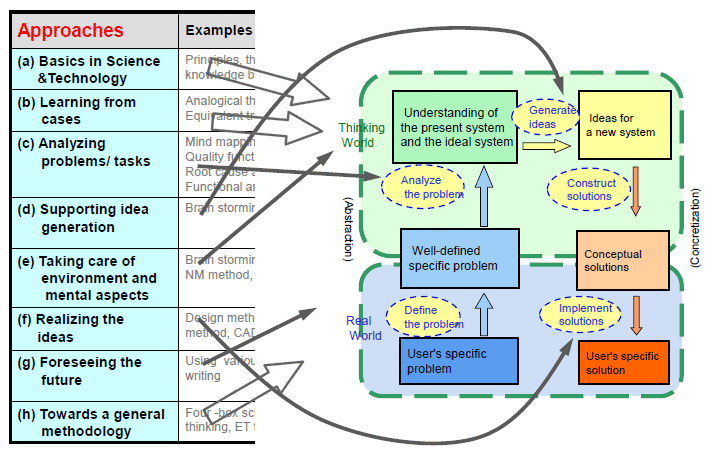
Figure 10: Understanding various "Creativity Methods" by positioning them
in the Basic Paradigm of "Six-Box Scheme" [12].
(a) Science and technology should incorporate the "Six-Box Scheme of Creative Problem Solving" (in its entirety) as a basic paradigm, in addition to the traditional "Four-Box Scheme of Abstraction".
(b) The approach of learning from examples is a simplified method of activities in the "Thinking World.
(c) The approach of organizing and analyzing problems and issues corresponds to the methods at the stages of problem definition (Box 1 to Box 2) and problem analysis (Box 2 to Box 3).
(d) Approaches of supporting idea generation deal with the idea generation stage (to Box 4), but they often skip the preparation stage (up to Box 3) in the "Six-Box Scheme".
(e) Approaches that emphasize the mental aspects put much stress on the mindset in the whole "Thinking World".
(f) Approaches of concretizing ideas correspond to the solution construction process (Box 4 to Box 5) in "Thinking World" and more significantly to the implementation process (Box 5 to Box 6) in the "Real World".
(g) Approaches of foreseeing the future and suggesting directions to go are handled primarily in the "Real World" and have a significant impact on how to think in the "Thinking World".
(h) The approaches of general methodology are related with the understanding and development of the "Six-Box Scheme" and its whole methodologies.
The above is an overview of positioning and organizing various "Creativity Methods" in the framework of "Six-Box Scheme", and we notice the importance of understanding each method and clarifying its characteristics and effectiveness [9]. In Section 3.2, the case study of "Saving Water for a Toilet Systems" is shown in the "Six-Box Scheme" and illustrates the Contradiction Solving method in TRIZ in a concise manner. It must be useful to show such illustrative examples for various "Creativity Methods" in order to organize a system of methodologies of "Creative Problem Solving".
4. Concluding Remarks
The main points presented in the present paper may be summarized as follows:
According to these findings, it should be important to understand various "Creativity Methods" in the new framework of "Basic Paradigm of Creative Problem Solving" and to reorganize them into a clear system of methodologies for Creative Problem Solving. Such a system of methodologies will contribute to research and development related to creativity and innovations in the whole world with the new basic framework and guidelines (Basic Paradigm).
References
[Note (TN, Feb. 19, 2022): The original paper in Japanese shows references mostly available in Japanese. In this English page, corresponding references are shown in their English editions whenever available. (J) in Japanese, (E) in Enlgish.]
[1] Toru Nakagawa (2021) Methodology of Creative Problem Solving: TRIZ and its Extensions -Scientific method for innovation-, Presented at Art Thinking Workshop, Tokyo, on Jun. 27, 2021 (in Japanese); THPJ/jpapers/2021Papers/jNaka-CrePSTalk-210627/jNaka-CrePSTalk-210627-VideoSlides-210705.html  (J); [Video] https://www.youtube.com/channel/UCx_pLqJqSvZN3zv48bDhTYQ
(J); [Video] https://www.youtube.com/channel/UCx_pLqJqSvZN3zv48bDhTYQ  (J)
(J)
[1A] Graham Wallas (1926), "The Art of Thought", J. Cape.
[2] Makoto Takahashi (ed.) (2002) "The Bible of Creativity", JUSE (Union of Japanese Scientists and Engineers), pp. 482. (in Japanese)
[3] Japanese Society for the Science of Design (Yoshiyuki Matsuoka) (ed.) (2019) "Encyclopedia of Design Science", Maruzen Publishing Co., pp. 705. (in Japanese)
[4] Toru Nakagawa (2005) A New Generation of TRIZ, Keynote Lecture, Presented at First TRIZ Symposium in Japan 2005, at Shuzenji, Shizuoka, on Sept. 1, 2005; eTHPJ/epapers/e2005Papers/e2005TRIZSymp0509/e1-1Nakagawa050915/e1-1Nakagawa050915.html  (E)
(E)
[5] Toru Nakagawa (2019) TRIZ, in "Encyclopedia of Design Science", Maruzen Publishing, pp. 550-555; THPJ/jpapers/2019Papers/Naka-DesignEncyclo-2019/Naka-Encyclo-TRIZ-191119.html  (J)
(J)
[6] Toru Nakagawa (2007) Introduction to USIT: A Simple Method for Creative Problem Solving, in "Machine Design" Journal (Nikkan Kogyo Shimbun), Aug. - Dec. 2007, A series of 5 lectures (in Japanese); (Short introduction in English) eTHPJ/epapers/e2007Papers/eNaka-MachineDesign-USIT07/eNaka-MD-USIT0.html  (E)
(E)
[7] Toru Nakagawa, Hideaki Kosha, and Yuji Mihara (2002) Reorganizing TRIZ Solution Generation Methods into Simple Five in USIT, Presented at ETRIA TRIZ Future Conf. 2002, at Strasbourg, France, on Nov. 6-8, 2002 (in English); eTHPJ/epapers/e2002NakaPapers/eETRIA02USIT0209/eETRIA02USIT0209.html  (E)
(E)
[8] Toru Nakagawa (2006) A New Paradigm for Creative Problem Solving: Six-Box Scheme in USIT, Presented at ETRIA TRIZ Future Conf. 2006, at Kortrijk, Belgium, on Oct. 6-8, 2006 (in English); eTHPJ/epapers/e2006Papers/eNakaETRIA-SixBox0610/eNakaETRIA-SixBox061028.html  (E)
(E)
[9] Toru Nakagawa (2014) General Methodology of Creative Problem Solving & Task Achieving (CrePS): Reorganizing Various Application Cases and Their Methods in the 'Six-Box Scheme', Presented at ETRIA TRIZ Future Conf. 2014, at Lausanne, Switzerland, on Oct. 29-31, 2014 (in English); eTHPJ/eTRIZ/epapers/e2014Papers/eNaka-CrePS-JTS-JCS-ETRIA-2014/eNaka-CrePS-JTS-JCS-ETRIA-141106.html  (E)
(E)
[10] Toru Nakagawa (2015) USIT: A Concise Process for Creative Problem Solving Based on the Paradigm of 'Six-Box Scheme' -- USIT Manual and USIT Case Studies --, Presented at ETRIA TRIZ Future Conf. 2015, at Berlin, Germany, on Oct. 26-29, 2015 (in English); eTHPJ/eTRIZ/epapers/e2016Papers/eNaka-ETRIATFC-2015/eNaka-TFC2015-USIT-160517-C-Paper.html  (E)
(E)
[11] Hong Suk Lee, Kyeong-Won Lee (2003) Practical Case Study of Resolving the Physical Contradiction in TRIZ; Super Water-Saving Toilet System Using Flexible Tube, TRIZ Journal, Nov. 2003 (in English); Japanese translation by Eiji Fukuzawa and Toru Nakagawa: THPJ/jpapers/2003Papers/LeeToilet0311/LeeToilet031127.htm  (J)
(J)
[12] Toru Nakagawa (2016) CrePS (General Methodology of Creative Problem Solving) beyond TRIZ: What, Why, and How?, Presented at Altshuller Institute TRIZCON2016, at New Orleans, USA, on Mar. 3-5, 2016 (in English); eTHPJ/epapers/e2016Papers/eNaka-TRIZCON2016-CrePS/eNaka-TRIZCON2016-CrePS-160613.html  (E)
(E)
Note: "TRIZ Home Page in Japan" (Editor: Toru Nakagawa) (since Nov. 1998),
THPJ/ URL:https://www.osaka-gu.ac.jp/php/nakagawa/TRIZ/  (Japanese pages)
(Japanese pages)
eTHPJ/ URL:https://www.osaka-gu.ac.jp/php/nakagawa/TRIZ/eTRIZ/  (English pages)
(English pages)
 Slides in English (Toru Nakagawa, Feb. 18, 2022) ==> Slides in PDF
Slides in English (Toru Nakagawa, Feb. 18, 2022) ==> Slides in PDF 
From the "Four-Box Scheme of Abstraction" in Science and Technology
to the "Six-Box Scheme" for Creative Problem Solving
(Toru Nakagawa)


1. Basic Paradigm of Science and Technology and Various "Creativity Methods"






2. Development: TRIZ and USIT: Towards Methodologies of Creative Problem Solving
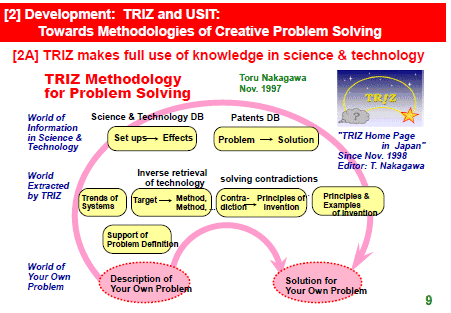

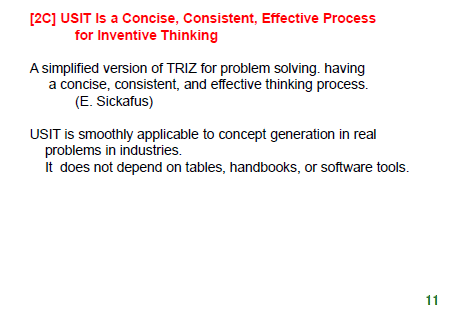


3. Six-Box Scheme: A New Paradigm of Creative Probelm Solving

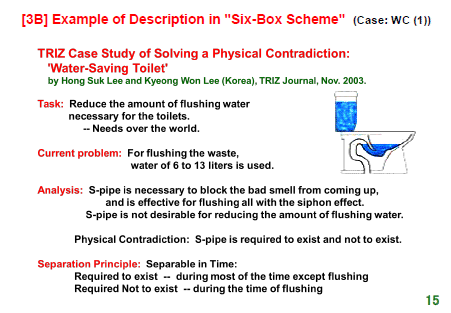


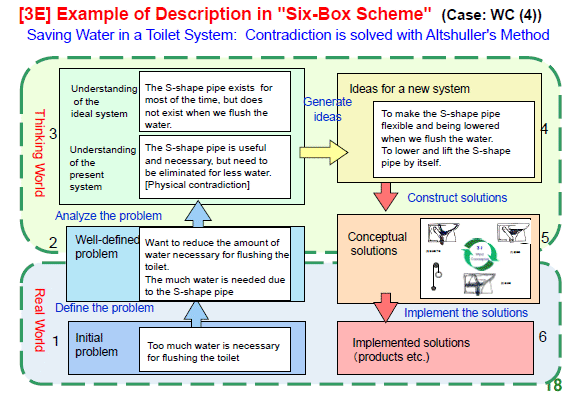


4. Concluding Remarks
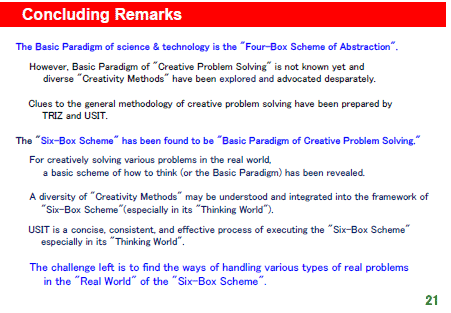

Last updated on Feb. 19, 2022. Access point: Editor: nakagawa@ogu.ac.jp
(Dec. 10,2021)
and slides
in English are posted in this page (Feb. 19, 2022, Toru Nakagawa)
(Jul. 22, 2022).

































